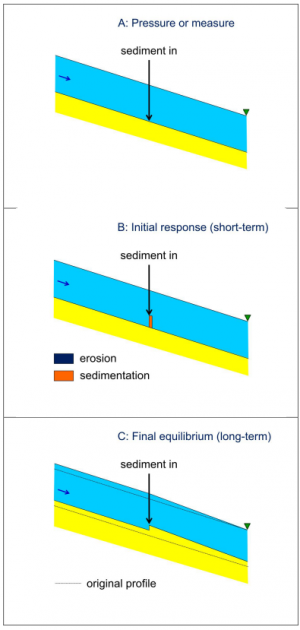Difference between revisions of "Effects of sediment supply"
(Created page with "<Forecasterlink type="getToolInfoBox" code="29" /> =Effects of sediment supply= ==Type== Diagrams of elementary morphological effects ==Rivertypes== <Forecasterlink type="ge...") |
|||
| Line 1: | Line 1: | ||
| − | + | ==Description== | |
| − | = | + | [[File:Effect of sediment supply.png|300px|thumbnail]] |
| − | + | The longitudinal profiles of Figures A to C visualize how sediment supply affects the main channel of a river reach. The vertical scale is exaggerated with respect to the horizontal scale. The reach can be kilometres to tens of kilometres long. The sediment considered is as coarse as the bed material, transported as bedload or in suspension. It does not regard the fine sediment that is transported in suspension as washload.<br /> | |
| − | + | ||
| − | |||
| − | < | + | The intervention implies essentially that sediment is supplied continuously to the river at a certain location (A). This produces punctuated local sedimentation without immediate effects on the water levels along the river (B). This sedimentation advances downstream as a shock wave. In a later stage, after sufficient sedimentation, the water levels increase above the area of sedimentation and further upstream. The corresponding lower flow velocities cause sedimentation upstream of the intervention.<br /> |
| + | |||
| + | Eventually, in the long run, the river reaches a new morphological equilibrium without further trends of erosion or sedimentation (C). All bed levels and water levels have become higher than at the start of the intervention.<br /> | ||
| + | |||
| + | If sediment is supplied during a limited period, only the initial response occurs. Eventually the river then restores its original profile.<br /> | ||
| + | |||
| + | The longitudinal profiles in the diagrams provide a simplified picture. They do not include the response of channel width, bed sediment composition or vegetation. Nonetheless, they offer the key to understanding the relation between local pressures or measures and their effects far upstream and downstream.<br /> | ||
| + | |||
==Related Pressures== | ==Related Pressures== | ||
| Line 19: | Line 24: | ||
<Forecasterlink type="getBqeForTool" code="29" /> | <Forecasterlink type="getBqeForTool" code="29" /> | ||
| − | |||
| − | |||
| − | |||
| − | |||
| − | |||
| − | |||
[[Category:Tools]][[Category:Diagrams of elementary morphological effects]] | [[Category:Tools]][[Category:Diagrams of elementary morphological effects]] | ||
Latest revision as of 14:14, 11 December 2015
Contents
Description
The longitudinal profiles of Figures A to C visualize how sediment supply affects the main channel of a river reach. The vertical scale is exaggerated with respect to the horizontal scale. The reach can be kilometres to tens of kilometres long. The sediment considered is as coarse as the bed material, transported as bedload or in suspension. It does not regard the fine sediment that is transported in suspension as washload.
The intervention implies essentially that sediment is supplied continuously to the river at a certain location (A). This produces punctuated local sedimentation without immediate effects on the water levels along the river (B). This sedimentation advances downstream as a shock wave. In a later stage, after sufficient sedimentation, the water levels increase above the area of sedimentation and further upstream. The corresponding lower flow velocities cause sedimentation upstream of the intervention.
Eventually, in the long run, the river reaches a new morphological equilibrium without further trends of erosion or sedimentation (C). All bed levels and water levels have become higher than at the start of the intervention.
If sediment is supplied during a limited period, only the initial response occurs. Eventually the river then restores its original profile.
The longitudinal profiles in the diagrams provide a simplified picture. They do not include the response of channel width, bed sediment composition or vegetation. Nonetheless, they offer the key to understanding the relation between local pressures or measures and their effects far upstream and downstream.
Related Pressures
Related Measures
Related Hymo quality elements
- River depth and width variation (Class: Morphological conditions)
- Structure and substrate of the river bed (Class: Morphological conditions)
Related Biological quality elements
- No Biological Quality Elements apply to this tool.
